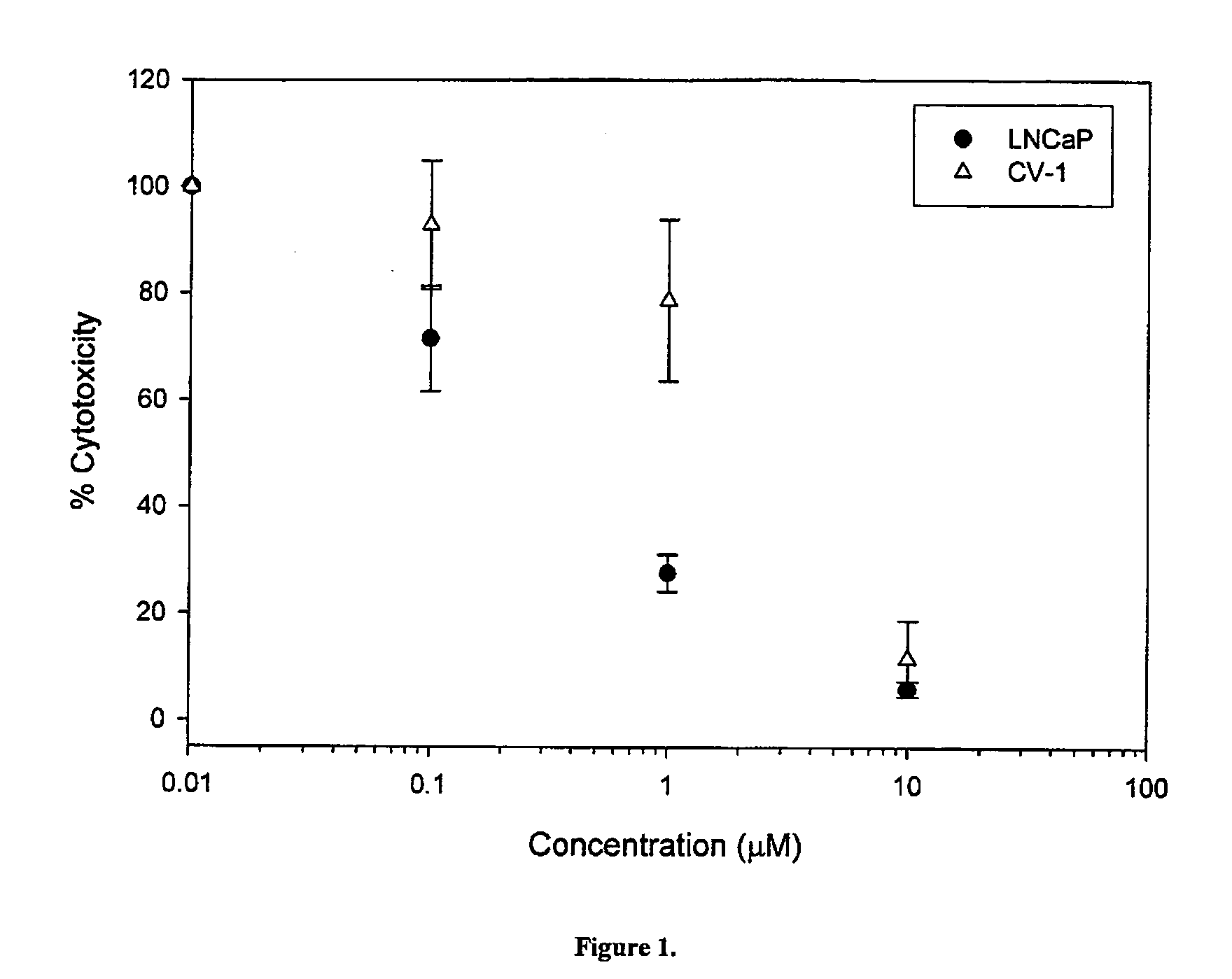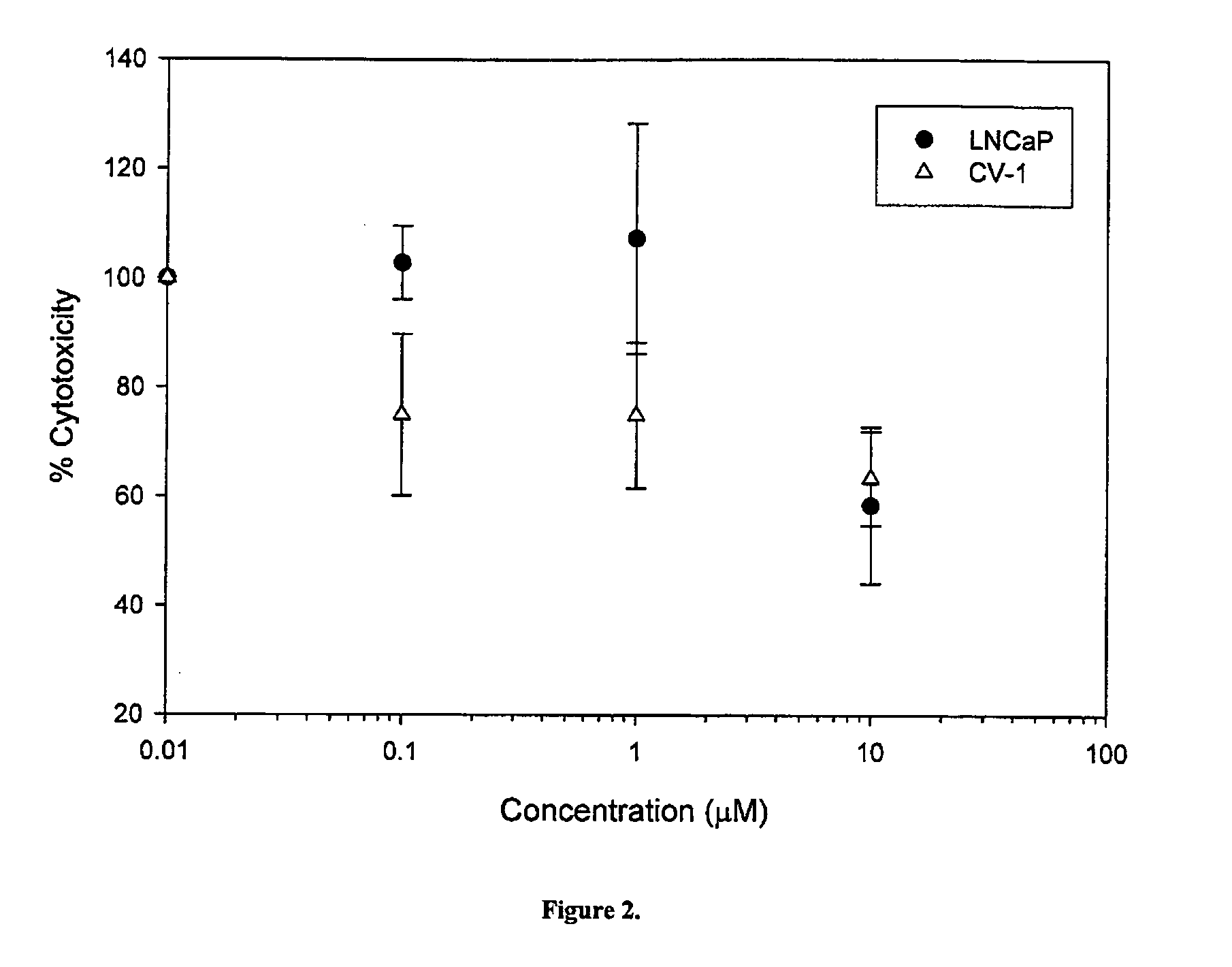Anti-cancer compounds and methods of use thereof
a technology of anticancer compounds and compounds, applied in the field of anticancer compounds, can solve the problems of reducing the specificity of the targeted agent, affecting the survival rate of patients, etc., and achieves the effects of suppressing, inhibiting or reducing the incidence of cancer, and high density expression
- Summary
- Abstract
- Description
- Claims
- Application Information
AI Technical Summary
Benefits of technology
Problems solved by technology
Method used
Image
Examples
example 1
Synthesis
[0339] The compounds of the present invention were synthesized according to the reactions set forth in Scheme 1 below:
General procedure for the synthesis of bromoanilide compounds (4, 5, and 28)
[0340] To a cold solution of bromoacid1 3 (0.29 mol) in 300 mL of THF was added SOCl2 (0.39 mol) in a dropwise manner under an argon atmosphere. The reaction mixture was stirred for 3 h under an ice-water bath and then Et3N (0.39 mol), aniline (1, 2, or 252, 0.19 mol) were added. The reaction mixture was stirred for 20 h at room temperature and concentrated under reduced pressure to give a solid which was treated with 300 mL of H2O. The solution was extracted with EtOAc (2×400 mL) and combined EtOAc extracts were washed with saturated NaHCO3 solution (2×300 mL) and brine (300 mL), successively. The organic layer was dried over MgSO4 and concentrated under reduced pressure to give an oil which was purified by column chromatography using CH2Cl2 / EtOAc (8:2) to give a solid which was...
example 2
Cytotoxicity of Select Compounds in LNCaP and CV-1 Cells
[0355] The effects of compounds 14, 7 and 8 on cell growth and proliferation in LnCaP prostate cancer cells (which express AR), and in CV-1 monkey kidney cells (which do not express AR) were studied. The structures of compounds 14, and the Androgen Receptor (AR) binding affinities are set forth in Table 2 below.
TABLE 2CompoundStructureKi (nM)1367 ± 562>770346296 ± 277175 ± 298271 ± 429 71 ± 5.5
Compounds and their Properties
[0356] The effects of compounds 14, 7, 8, 10 on cell growth, proliferation and viability in LnCaP prostate cancer cells (which express AR), and in CV-1 monkey kidney cells (which do not express AR) were studied. The structures of compounds 1-4 and 6-15, and the respective Ki values are set forth in Table 3 below.
[0357] The effects of compounds 11-15 in terms of cell viability can be determined comparably to compounds 1-10.
TABLE 3KiGrowth CurveNameStructure(nM)AssayLNCaPCV-1Andromustine 1 367Trypan Bl...
PUM
| Property | Measurement | Unit |
|---|---|---|
| incubation time | aaaaa | aaaaa |
| incubation time | aaaaa | aaaaa |
| incubation time | aaaaa | aaaaa |
Abstract
Description
Claims
Application Information
 Login to View More
Login to View More - R&D
- Intellectual Property
- Life Sciences
- Materials
- Tech Scout
- Unparalleled Data Quality
- Higher Quality Content
- 60% Fewer Hallucinations
Browse by: Latest US Patents, China's latest patents, Technical Efficacy Thesaurus, Application Domain, Technology Topic, Popular Technical Reports.
© 2025 PatSnap. All rights reserved.Legal|Privacy policy|Modern Slavery Act Transparency Statement|Sitemap|About US| Contact US: help@patsnap.com



